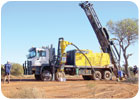
Reverse circulation drilling was developed to allow for larger borehole drilling without limiting the factors of drilling fluid pump capacities. Rotary rigs designed for reverse circulation have larger-capacity mud pumps and air compressors to allow for increased pressures that are needed to ensure the removal of cuttings from large boreholes. These drill rigs are far larger than those used for domestic purposes.
Centrifugal mud pumps often are used instead of displacement because the cuttings will more easily circulate through a centrifugal-type pump than through a positive displacement pump.
Reverse circulation rotary drilling is a variant of the mud rotary method, in which drilling fluid flows from the mud pit down the borehole outside the drill rods and passes upward through the bit. Cuttings are carried into the drill rods and discharged back into the mud pit.
Reverse circulation requires a lot of water and sediment-handling, as the boreholes are large in diameter. Stability of the borehole depends on the positive pressure from the fluid in the borehole annulus. If the positive pressure is not sufficient, the borehole wall or parts of it might collapse, trapping the drill string.
For reverse circulation rotary drilling, the drilling fluid can best be described as muddy water rather than drilling fluid; drilling fluid additives seldom are mixed with the water to make a viscous fluid. Suspended clay and silt that re-circulates with the fluid mostly are fine materials picked up from the formations as drilling proceeds. Occasionally, low concentrations of a polymeric drilling fluid additive are used to reduce friction, swelling of water-sensitive clays, and water loss. Because fewer drilling muds are used, no wall cake is created, and the stabilization by the borehole fluid is needed.
To prevent caving of the hole, the fluid level must be kept at ground level at all times – even when drilling is suspended temporarily – to prevent a loss of hydrostatic pressure in the borehole. The hydrostatic pressure of the water column, plus the velocity head of the downward moving water outside the drill pipe are what support the borehole wall. Erosion of the wall usually is not a problem because velocity in the annular space is low.
A considerable quantity of makeup water usually is required and must be immediately available at all times when drilling in permeable sand and gravel. Under these conditions, water loss can suddenly increase, and, if this causes the fluid level in the hole to drop significantly below the ground surface, caving usually is the result. Water loss can be addressed by the addition of clay additives, but this action is only taken as a last resort.
Often, to aid the upward movement of water through the drill string, air is injected, lifting the contents to the surface. Another reason to use air is the fact that the suction pump lift is limited in its capacity to create enough vacuum to start up the water movement after a rod change. When air lifting is used to assist in reverse mud drilling, this method becomes similar to the reverse air rotary method.
Reverse mud is a cost-effective method for drilling borehole 24-inches and greater, and is most successful in unconsolidated formations.
ND
Advantages of Reverse Circulation Mud Rotary
- The near-well area of the borehole is relatively undisturbed and uncontaminated with drilling additives, and the porosity and permeability of the formation remains close to its original hydrogeologic condition.
- Large-diameter holes can be drilled quickly and economically.
- No casing is required during the drilling operation.
- Most geologic formations can be drilled, with the exceptions being igneous and metamorphic rocks.
- Little opportunity exists for washouts in the borehole, because of the low velocity of the drilling fluid.
Limitations of Reverse Circulation Mud Rotary
- Large water supply generally is needed.
- Reverse-rotary rigs and components are large and expensive.
- Large mud pits are required.
- Some drill sites are inaccessible because of the rig size.
- For efficient operation, more personnel generally are required than for other drilling methods.
This article is provided through the courtesy of the International School of Well Drilling (ISWD), which serves operators around the country, providing a wide variety of training and consulting services. The school has provided customized training programs ranging from those for experienced employees to basic training for those new to the industry. Specific consulting projects also are undertaken. To contact ISWD, telephone 863-648-1565; e-mail director@welldrillingschool.com; or visit www.welldrillingschool.com.



Report Abusive Comment